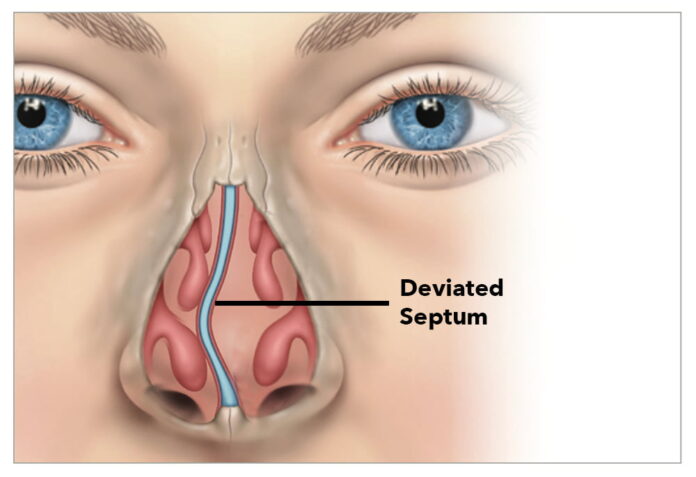Millions of people suffer from breathing problems caused by a deviated septum, which can affect daily life and overall health. In severe cases, it can even disrupt sleep, leading to decreased energy and productivity. While there are several ways to treat this issue, rhinoplasty is a surgical procedure that can effectively correct a deviated septum while enhancing the overall appearance of the nose. Let’s explore how rhinoplasty can improve breathing function, what to expect during and after the procedure, and how to choose the right surgeon and the right clinic for the job.
The Importance of Breathing Properly
Breathing is essential for our bodies to receive the oxygen that fuels our organs and muscles. Breathing problems can cause a range of issues, including headaches, dizziness, and fatigue.
When the septum, the structure between the nostrils, is damaged or uneven, it can cause one nasal passage to be much smaller than the other, leading to restricted airflow. This condition is called a deviated septum.
A deviated septum can negatively impact your health and daily life. It can lead to sinus infections, snoring, difficulty breathing through the nose, and even breathing-related sleep disorders like sleep apnea. In severe cases, it can also impact athletic performance and overall physical capabilities. Be sure to talk to the Diepenbrock Facial Cosmetic Surgery to get more information about it.
How Rhinoplasty Can Help
Rhinoplasty can correct deformation and improve the appearance of the nose. The surgery involves reshaping the nose and repairing the deviated septum. Rhinoplasty can significantly improve breathing function by opening the blocked airway, making it easier to breathe.
The surgical techniques involved in rhinoplasty depend on the individual patient’s features and what needs to be corrected. A surgeon can opt to make small incisions inside the nose or both inside and outside, depending on the severity and shape of the deviated septum. The surgeon will then adjust the shape of the septum and reposition it in the middle of the nose.
After the procedure, the patient can experience some swelling and discomfort for a few days, and the surgeon may place medical packing to prevent nasal bleeding. The recovery time can differ depending on the patient and the surgical techniques the surgeon uses.
Rhinoplasty not only provides a solution for breathing problems caused by a deviated septum but also offers the opportunity to correct cosmetic concerns, including bumps, asymmetry and other shape issues. Thus, the procedure can benefit those who are interested in improving their physical appearance as well as those who require going under the procedure for functional improvement.
What to Expect During and After the Procedure
Recovering from surgery may take several weeks or more, depending on the extent of the surgical procedure. During the recovery period, patients must take good care of their noses and follow the surgeon’s instructions to ensure optimal healing and results. At first, the patient may experience some discomfort, swelling, and mild pain, but the surgeon may prescribe medication to manage the symptoms.
It’s crucial to avoid any physical activities, including heavy lifting or exercise, as it can increase blood flow and cause bleeding. Patients should also avoid touching their noses or blowing their noses during the recovery period to prevent damage to the nasal tissue.
After the recovery period, patients may notice significant changes in their breathing function, including a considerable reduction in snoring and other breathing-related issues. Rhinoplasty can significantly improve your quality of life, and in some cases, it can even correct sleep apnea.
Choosing the Right Surgeon
Rhinoplasty is a complex surgical procedure that requires a high level of skill and expertise. Hence, it’s essential to find a qualified and experienced surgeon to minimize complications and obtain the desired outcome.
Reviewing a surgeon’s credentials and experience is a good place to start. Look for board-certified surgeons, which indicate that they have passed a rigorous exam and adhere to professional ethical standards. Additionally, consider the surgeon’s experience in performing rhinoplasty surgeries, as this can indicate their level of expertise.
Before the procedure, take advantage of the consultation and ask questions about the procedure, the surgeon’s experience and qualifications, and what to expect during the recovery period. The surgeon should provide details about the surgical techniques they plan to use and explain the expected outcome of the procedure.
You need to feel comfortable with the surgeon you choose. Building trust with your doctor can make the process of undergoing surgery less stressful and more comfortable.
Read Also
- Why comprehensive health insurance with maternity is beneficial in the UAEWelcoming a child is a significant milestone in any family’s journey. As exciting as this chapter is, it also brings with it a fair share of responsibilities—especially when it comes to planning for healthcare costs. Health insurance is now mandatory in the UAE, but as with any type of insurance, the smallest requirement might not… Read more: Why comprehensive health insurance with maternity is beneficial in the UAE
- Modern Approaches to Adolescent Mental Health Treatment for Lasting RecoveryWith increasing numbers of teens experiencing emotional and behavioral health concerns, adolescent mental health treatment has become more essential than ever. Conditions such as anxiety, depression, trauma and mood instability are on the rise, and effective support must evolve with these growing needs. Today’s treatment models blend evidence-based therapy with flexible access and holistic care, giving… Read more: Modern Approaches to Adolescent Mental Health Treatment for Lasting Recovery
- How to Find a 5-Star Dentist Near YouChoosing a dentist is more than just finding someone who can clean your teeth. It’s about selecting a trusted partner in your long-term oral health. A 5-star dentist not only provides excellent clinical care but also delivers a positive patient experience, from the moment you walk in until the moment you leave. Whether you’re new… Read more: How to Find a 5-Star Dentist Near You
- Your Easy-Peasy Guide to Brewing Amazing MatchaHey there! So, you’ve heard all the buzz about matcha – that vibrant green powder that’s not just pretty but packed with good stuff? It can seem a little fancy and intimidating at first, but trust me, making a delicious cup at home is simpler than you think. Forget complicated ceremonies for now; let’s just… Read more: Your Easy-Peasy Guide to Brewing Amazing Matcha
- Embracing Holistic Wellness: Insights from a Lansing, MI Health CenterReframing Health: Moving Beyond Symptom Management Treating only symptoms often offers quick relief, yet long-term results stay out of reach. When care zeroes in on isolated complaints, the bigger picture, such as stress, behavior, or lifestyle, often gets missed. Research shows that whole-person care, which looks at physical, emotional, and environmental factors, yields better outcomes… Read more: Embracing Holistic Wellness: Insights from a Lansing, MI Health Center






